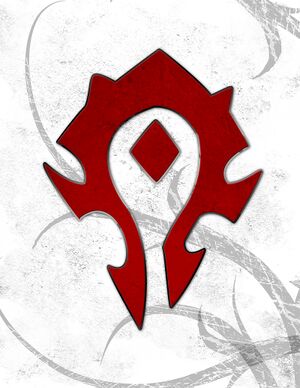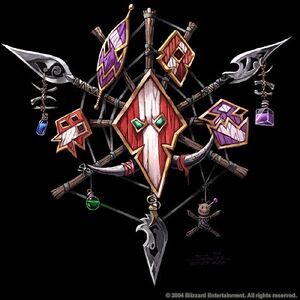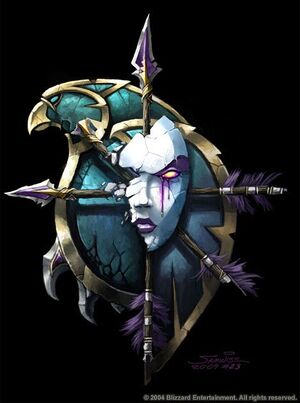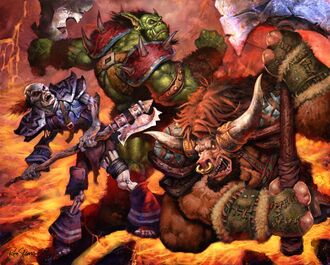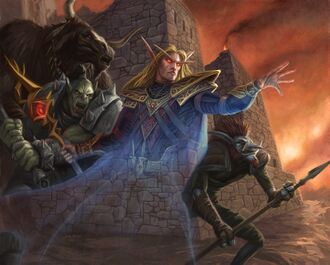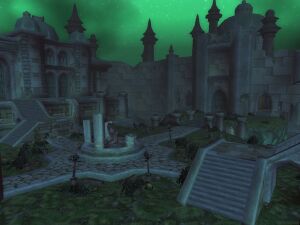User:Armen80721/Tol'vir/Horde
- The Horde is made up of orcs, forsaken, tauren, trolls, blood elves, and most recently, goblins. Misunderstood and cast aside, these diverse and powerful races strive to overcome their differences and unite as one in order to win freedom for their people and prosper in a land that has come to hate them.
- In the Horde, action and strength are valued above diplomacy, and its leaders earn respect by the blade, wasting no time with politics. The brutality of the Horde's champions is focused, giving a voice to those who fight for survival.[1]
The Horde is one of the two major political factions of the mortal races in Azeroth, its counterpart being the Alliance. The Horde, a faction led by off-worlders and composed of outsiders has survived these obstacles by bonding together, fighting as family, comrades, or even uneasy allies.[2]
Members
Major members
Major member races include:
Durotar
![]()
![]() Orc - The surviving orcs of Azeroth's First, Second and Third Wars, who were released by Thrall from the Internment camps of Lordaeron and led by him to form their new destiny in Kalimdor while attempting to re-embrace their once honorable, shamanistic ways and fight the corruption of demonic magic. Capital is Orgrimmar in Durotar.
Orc - The surviving orcs of Azeroth's First, Second and Third Wars, who were released by Thrall from the Internment camps of Lordaeron and led by him to form their new destiny in Kalimdor while attempting to re-embrace their once honorable, shamanistic ways and fight the corruption of demonic magic. Capital is Orgrimmar in Durotar.
- Led by
 Warchief Garrosh Hellscream
Warchief Garrosh Hellscream - They have a large presence in Central Kalimdor. After the Dark Portal opened the orcs make bases in Outland to investigate their past. They also have bases in Northrend where they fought against the Scourge.
The Orcs in the Horde are from the following clans:
- Frostwolves - Thrall's own clan, and one of the few clans in the Eastern Kingdoms.
- Warsong - A powerful warrior clan that battle the elves for Ashenvale.
- Led by
 Garrosh Hellscream
Garrosh Hellscream
- Led by
- Bleeding Hollow - The clan returned to Draenor after the Second War, but as it was torn apart some members crossed safely into Azeroth at the same time as the Warsong clan. They were captured and later rescued from the internment camps, and now they serve the new Horde. Additionally they have a notable presence in the Mag'har.
- Led by
 Jorin Deadeye
Jorin Deadeye
- Led by
- Burning Blade - The blademasters were once part of the Burning Blade, although the clan consumed itself in the throes of demonic corruption, these few swordsmen are still part of the Horde.
- Led by
 Neeru Fireblade
Neeru Fireblade
- Led by
- Dragonmaw - The Dragonmaw clan residing in the Twilight Highlands, have recently joined the new Horde.[3]
- Led by
 Warlord Zaela
Warlord Zaela
- Led by
- Rageroar - A newly created clan that was assaulting Northwatch hold. It is destroyed at the end of the Alliance questline.[4]
- Led by
 Karga Rageroar
Karga Rageroar
- Led by
- Shadowmoon - Scouts are seen fighting for the New Horde at Shadowmoon Village.
- Led by
 Overlord Or'barokh
Overlord Or'barokh
- Led by
- Shattered Hand - The Azerothian part of the clan have joined Thrall and serve as the Horde's guild of assassins.
- Led by
 Gordul
Gordul
- Led by
- Twilight's Hammer - At least one orc that was in the clan before it was a cult fights for the Horde.[5]
- Blackrock - Eitrigg, Ariok and Varok Saurfang are former members of this clan. Furthermore, Garrosh Hellscream has recently granted the clan amnesty and recruited a formidable number of them into his ranks, most notably his new bodyguard and advisor, Malkorok. Also, an increasing amount of the new elite Kor'kron are members of this clan and act as some sort of secret police force for Garrosh.
- Led by
 Malkorok
Malkorok
- Led by

 Half-ogre - Many of Azeroth's Half-Ogres assist the Horde when called on.
Half-ogre - Many of Azeroth's Half-Ogres assist the Horde when called on.
 Half-orc - Many aligned with their orcish relatives. Some joined the Alliance.
Half-orc - Many aligned with their orcish relatives. Some joined the Alliance. Wyvern - The Horde has befriended many of these intelligent beasts of Kalimdor, whom they use as riding and flying mounts.
Wyvern - The Horde has befriended many of these intelligent beasts of Kalimdor, whom they use as riding and flying mounts.
 Black Dragons - The Dragonmaw have enslaved members of the Black Dragonflight to serve them as mounts.
Black Dragons - The Dragonmaw have enslaved members of the Black Dragonflight to serve them as mounts.
Darkspear Tribe
![]()
![]() Jungle troll - Originally from a small chain of islands in the Great Sea. Eventually joined Thrall’s journey to Kalimdor and moved to the Echo Isles, but were then rooted out by the Kul Tiras marines. They are forever indebted to the orcs for saving their tribe and giving them a home. Capital is Darkspear Isle, the largest of the Echo Isles, off the coast of Durotar.
Jungle troll - Originally from a small chain of islands in the Great Sea. Eventually joined Thrall’s journey to Kalimdor and moved to the Echo Isles, but were then rooted out by the Kul Tiras marines. They are forever indebted to the orcs for saving their tribe and giving them a home. Capital is Darkspear Isle, the largest of the Echo Isles, off the coast of Durotar.
- Led by
 Chieftain Vol'jin
Chieftain Vol'jin - Prior to the reclamation of the Echo Isles, Sen'jin Village in mainland Durotar was the main Darkspear settlement. Darkspear settlements are commonly found in Kalimdor or Outland.
- The Ravasaur Trainers in Un'goro Crater are a group of Darkspear troll elite raptors riders that provide their mounts to members of the Horde who prove themselves able to survive the creature's poison.
United Tauren Tribes
![]()
![]() Tauren - A race of noble creatures, native to Kalimdor, who befriended the orcs and offered them spiritual guidance and aid. Capital is Thunder Bluff in Mulgore.
Tauren - A race of noble creatures, native to Kalimdor, who befriended the orcs and offered them spiritual guidance and aid. Capital is Thunder Bluff in Mulgore.
- Led by
 High Chieftain Baine Bloodhoof
High Chieftain Baine Bloodhoof - They also have many camps in Kalimdor. They have also sent ambassadors to their cousins, the taunka, in Northrend.
- Sunwalkers - Paladins who take their power from An'she.
- Led by
 Aponi Brightmane and
Aponi Brightmane and  Tahu Sagewind.
Tahu Sagewind.
- Led by
The Tauren of the Horde come from various tribes:
- Bloodhoof - The first Tauren tribe to side with the Horde, they are led by Baine Bloodhoof in the wake of his father's death at the hands of Magatha Grimtotem.
- Led by
 Baine Bloodhoof
Baine Bloodhoof
- Led by
- Ragetotem - Proud warriors and the fiercest of Thunder Bluff. Formerly led by Sark Ragetotem.
- Dawnstrider - Experienced enchanters and skilled shamans.
- Runetotem - These tauren have recently discovered the ways of the druid.
- Led by
 Hamuul Runetotem
Hamuul Runetotem
- Led by
- Highmountain - A tribe with several notable members who fought (and still fight) against the Burning Legion. Trag Highmountain is a former member of the tribe.
- Skychaser - The spiritual leaders of the tauren shaman. They were nearly wiped out during the Grimtotem coup to take over Thunder Bluff.
- Thunderhorn - Most of the Thunderhorn tribe are hunters, the greatest among the tauren.
- Grimtotem - The Grimtotem tauren that survived the battle at Thunder Bluff and chose to follow Jevan Grimtotem and ally with the Horde.
- Led by
 Jevan Grimtotem
Jevan Grimtotem
- Led by
- Cloudsong – They picked up the role of spiritual leaders of the tauren shamans after the Skychaser tribe was nearly wiped out.
- Eageltalon – This tribe hunts the harpies of Mulgore.
- Mistrunner – The Mistrunners tribe is dedicated to the druidic path and seeks to heal the earth and ease the suffering of the Earthmother.
- Stonehoof – The Stonehoof are the most talented smiths among the tauren.
- Led by
 Zangen Stonehoof
Zangen Stonehoof
- Led by
- Wildmane – This tribe has largely joined the Runetotem in seeking the ways of the druid.
- Winterhoof – The Winterhoof tribe represents some of the greatest herbalists and alchemists the tauren have to offer.
- Stonespire Tribe - A tauren tribe that lived in the Southern Barrens. Most were killed by the forces of Bael'dun Keep but there are a few survivors.
- Cliffwalker - A tribe based in Cliffwalker Post with strong ties to druidism.
- Led by
 High Chieftain Cliffwalker
High Chieftain Cliffwalker
- Led by
- Dawnchaser - A tribe of Horde tauren from Thunder Bluff that have come to Pandaria. One of their main outposts in Pandaria is located in the Krasarang Wilds at Thunder Cleft.
- Led by
 Cheftain Dezco
Cheftain Dezco
- Led by
Forsaken
![]()
![]() Forsaken - Known as the Forsaken, this group of undead was released from the control of the Lich King and have entered into an alliance of convenience with the other members of the Horde. The group also consists of other undead creatures, such as the Val'kyr, who chose to join the Forsaken after the Lich King's death. The capital is the Undercity, beneath the ruined City of Lordaeron in Tirisfal Glades.
Forsaken - Known as the Forsaken, this group of undead was released from the control of the Lich King and have entered into an alliance of convenience with the other members of the Horde. The group also consists of other undead creatures, such as the Val'kyr, who chose to join the Forsaken after the Lich King's death. The capital is the Undercity, beneath the ruined City of Lordaeron in Tirisfal Glades.
- Led by
 Queen Sylvanas Windrunner.
Queen Sylvanas Windrunner. - They also have holdings in Silverpine Forest and the Hillsbrad Foothills, as well as towns in the Howling Fjord and the Dragonblight in Northrend.
- Royal Apothecary Society - A faction of Forsaken alchemists trying to create a new plague to wipe out the Scourge and, perhaps, humanity.[6].
- Led by
 Faranell
Faranell 
 Leper gnome - A few leper gnomes have sworn fealty to Sylvanas and act as assistants to the apothecaries.
Leper gnome - A few leper gnomes have sworn fealty to Sylvanas and act as assistants to the apothecaries.
- Led by
- Deathguard - The bulk of the Forsaken military force. They are mostly stationed in the Tirisfal Glades, Silverpine Forest, and the Hillsbrad Foothills, as well as Forsaken outposts in Northrend.
- Cult of the Forgotten Shadow - The official Forsaken religion. There is no official leader but some minor characters have a major influence over it.
- Unoffically led by
 Aelthalyste
Aelthalyste
- Unoffically led by
- Deathstalkers - The Forsaken military faction of assassins and rogues.
- Led by
 Commander Belmont
Commander Belmont
- Led by
The Forsaken employ various different types of undead.
 Skeleton - Sylvanas and her necromancers are known to summon skeletons to battle.
Skeleton - Sylvanas and her necromancers are known to summon skeletons to battle.
 Undead elf - Various former high elven citizens serve the Banshee Queen.
Undead elf - Various former high elven citizens serve the Banshee Queen. Banshee - Sylvanas has many banshee allies and is known as the banshee queen.
Banshee - Sylvanas has many banshee allies and is known as the banshee queen. Val'kyr - Following the death of the Lich King, many Val'kyr swore fealty to Sylvanas and raise slain enemies as Forsaken. They are, however, only capable of raising humans.[7]
Val'kyr - Following the death of the Lich King, many Val'kyr swore fealty to Sylvanas and raise slain enemies as Forsaken. They are, however, only capable of raising humans.[7] Abomination - The Forsaken keep a large amount of abominations in their service.
Abomination - The Forsaken keep a large amount of abominations in their service. Zombie - The Forsaken has some zombies within their ranks such as Algernon and Boyle.
Zombie - The Forsaken has some zombies within their ranks such as Algernon and Boyle.
![]() Sylvanas was able to produce the following during the events of the Third War:
Sylvanas was able to produce the following during the events of the Third War:
 Obsidian Statue - During the Third War, Sylvanas was able to produce Obsidian Statues.
Obsidian Statue - During the Third War, Sylvanas was able to produce Obsidian Statues. Ghouls - When Sylvanas first was freed from Arthas, all she had was her banshees and a small group of ghouls.
Ghouls - When Sylvanas first was freed from Arthas, all she had was her banshees and a small group of ghouls. Crypt Fiends - During the Third War, Sylvanas had a group of crypt fiends in her forces.
Crypt Fiends - During the Third War, Sylvanas had a group of crypt fiends in her forces. Gargoyles - Sylvanas was also able to produce a few gargoyles.
Gargoyles - Sylvanas was also able to produce a few gargoyles. Frost Wyrms - Sylvanas eventually learned how to raise Frost Wyrms.
Frost Wyrms - Sylvanas eventually learned how to raise Frost Wyrms.
Kingdom of Quel'Thalas
![]()
![]() Blood elf - Dealt a devastating blow during the Scourge invasion of Quel'Thalas, the high elves cast off their name and dubbed themselves the "blood elves," in honor of the fallen. Tirelessly working to reclaim their homeland from the lingering Scourge and the ever-vengeful Amani, the sin'dorei sought to join the reformed Horde with the strong backing of their former ranger general, Lady Sylvanas Windrunner. With the Sunwell restored and the monumental betrayal of their prince behind them, a bright future now lies ahead for the blood elves of Quel'Thalas.[8] Capital is Silvermoon City in Eversong Woods, in northern Quel'Thalas.
Blood elf - Dealt a devastating blow during the Scourge invasion of Quel'Thalas, the high elves cast off their name and dubbed themselves the "blood elves," in honor of the fallen. Tirelessly working to reclaim their homeland from the lingering Scourge and the ever-vengeful Amani, the sin'dorei sought to join the reformed Horde with the strong backing of their former ranger general, Lady Sylvanas Windrunner. With the Sunwell restored and the monumental betrayal of their prince behind them, a bright future now lies ahead for the blood elves of Quel'Thalas.[8] Capital is Silvermoon City in Eversong Woods, in northern Quel'Thalas.
- Led by
 Regent Lord Lor'themar Theron.
Regent Lord Lor'themar Theron. - Magisters - The primary magic users of Quel'Thalas.
- Led by
 Grand Magister Rommath.
Grand Magister Rommath.
- Led by
- Farstriders - The ancient order of Thalassian rangers. Now blood elves, they are dedicated to safeguarding their homeland from any and all threats, near and far while maintaining the old, nature-revering ways of their people.
- Led by
 Halduron Brightwing.
Halduron Brightwing.
- Led by
- Blood Knights - Silvermoon's order of blood elf paladins formed after the capture of the Naaru M'uru at Tempest Keep. Once, they drained power from the Naaru but, after the events at the Sunwell Plateau during the Invasion of Outland, the Naaru's spark transformed the Sunwell into a font of Holy Light from which these paladins could draw power.
- Led by
 Lady Liadrin.
Lady Liadrin.
- Led by
- The Sunfury - A ruthless blood elven military force once under the command of Prince Kael'thas. Many have since returned home to Quel'Thalas, following the betrayal of their prince to the Burning Legion.[9]
- The Reliquary - A group of examiners and archaeologists out to give the Horde a monopoly on magical artifacts.
- Led by
 Tae'thelan Bloodwatcher.
Tae'thelan Bloodwatcher.
- Led by
- They also have holdings in the Ghostlands, alongside the Forsaken and an encampment in Hellfire Peninsula in Outland, to support blood elf pilgrims traveling through the Dark Portal from Azeroth. The Reliquary has a number of blood elven camps in and adjacent to the Badlands, Tanaris, and the Blasted Lands.
![]() Arcane Guardian - The blood elves use the arcane guardians for protection from invaders. The golems patrol all around Silvermoon City.
Arcane Guardian - The blood elves use the arcane guardians for protection from invaders. The golems patrol all around Silvermoon City.
Bilgewater Cartel
![]()
![]() Goblin - With the Cataclysm consuming their home island of Kezan, the goblins of the Bilgewater Cartel are shipped across the sea, intended for slave labor in Azshara, when they are caught in a naval crossfire between an Alliance fleet and a single Horde vessel off the Lost Isles. While there, they are attacked by the Alliance and ally with the orcs to defeat both their mutual foe, the hostile natives of the Lost Isles, and dissent from within their own ranks.
Current home is Bilgewater Harbor in the heavily-reshaped Azshara. The goblins also have a district led by Boss Mida within the orcish capital of Orgrimmar.
Goblin - With the Cataclysm consuming their home island of Kezan, the goblins of the Bilgewater Cartel are shipped across the sea, intended for slave labor in Azshara, when they are caught in a naval crossfire between an Alliance fleet and a single Horde vessel off the Lost Isles. While there, they are attacked by the Alliance and ally with the orcs to defeat both their mutual foe, the hostile natives of the Lost Isles, and dissent from within their own ranks.
Current home is Bilgewater Harbor in the heavily-reshaped Azshara. The goblins also have a district led by Boss Mida within the orcish capital of Orgrimmar.
- Led by
 Trade Prince Jastor Gallywix.
Trade Prince Jastor Gallywix. - Bilgewater Battalion - The new army and defence force of the Bilgewater Cartel of goblins created after the cartel pledged allegiance to the Horde.
- Led by
 Uncle Bedlam
Uncle Bedlam
- Led by
 Hobgoblins - huge chemically altered goblins have come with the goblins. In-game goblins can summon them to access the bank.
Hobgoblins - huge chemically altered goblins have come with the goblins. In-game goblins can summon them to access the bank.
Huojin Pandaren
![]()
![]() Pandaren - Huojin are a pandaren faction of the Wandering Isle, that has decided to join the Horde ranks, giving the similiarities in the moral code of its races. Huojin philosophy states that inaction is the greatest injustice, and that there is no shame in defending one's homes and loved ones regardless of cost.
Pandaren - Huojin are a pandaren faction of the Wandering Isle, that has decided to join the Horde ranks, giving the similiarities in the moral code of its races. Huojin philosophy states that inaction is the greatest injustice, and that there is no shame in defending one's homes and loved ones regardless of cost.
- Led by
 Ji Firepaw.
Ji Firepaw.
Horde Forces
The uneasy truce between the Alliance and the Horde in the aftermath of the Third War was soon broken when several battlegrounds between various forces of the factions have erupted:
Classic

 Frostwolf clan – This clan settled in the hidden Alterac Mountains after their exile by Gul'dan. However the Stormpike Dwarves later arrived to search for artifacts causing conflict between the two.
Frostwolf clan – This clan settled in the hidden Alterac Mountains after their exile by Gul'dan. However the Stormpike Dwarves later arrived to search for artifacts causing conflict between the two.
- Led by
 Drek'thar
Drek'thar
- Led by

 Defilers – A force of Forsaken sent to gather resources of Arathi Basin, found themselves fighting a vicious war with the League of Arathor, humans who are native to the land of Arathi who in turn are fighting to gather resources for the Alliance.
Defilers – A force of Forsaken sent to gather resources of Arathi Basin, found themselves fighting a vicious war with the League of Arathor, humans who are native to the land of Arathi who in turn are fighting to gather resources for the Alliance.
- Led by
 The Black Bride
The Black Bride
- Led by

 Warsong Outriders – Following the Third War, the Warsong clan that invaded Ashenvale and began deforestation have not ceased their operation and have come into direct conflict with the Silverwing Sentinels.
Warsong Outriders – Following the Third War, the Warsong clan that invaded Ashenvale and began deforestation have not ceased their operation and have come into direct conflict with the Silverwing Sentinels.
- Led by
 Gargok
Gargok
- Led by
Burning Crusade
- Thrallmar - is the name for the Horde expeditionary forces to Outland, who quickly found many native allies. Consist of all the Horde races. The expedition's settlements are scattered all over Outland's zones, except Nagrand and Netherstom.
- Led by
 Nazgrel
Nazgrel
- Led by

 Mag'har - Mag'har are orcs from various clans that escaped corruption and remained in Outland throughout all three wars.
Mag'har - Mag'har are orcs from various clans that escaped corruption and remained in Outland throughout all three wars.
- Led by
 Greatmother Geyah
Greatmother Geyah
- Led by
Wrath of the Lich King (Horde Expedition)
- Warsong Offensive - The main forces of the horde's expedition to northrend, led by Garrosh Hellscream.
- Kor'kron Guard - the elite fighting forces of the Horde, serving the Horde Expedition in Northrend.
- Led by
 Varok Saurfang
Varok Saurfang

 Taunka - Ancient relatives of the tauren, were thought to be lost until re-discovered by Garrosh Hellscream and his orc forces upon their arrival to Northrend. They are welcomed into the Horde soon after Roanauk Icemist is rescued.
Taunka - Ancient relatives of the tauren, were thought to be lost until re-discovered by Garrosh Hellscream and his orc forces upon their arrival to Northrend. They are welcomed into the Horde soon after Roanauk Icemist is rescued.
- Led by
 Roanauk Icemist
Roanauk Icemist
- Led by

 Hand of Vengeance - A group of Forsaken forces that have been sent to Northrend by Sylvanas Windrunner to bring Undercity's vengeance upon the Lich King. Their method is the delivery of the latest strain of their deadly Plague.
Hand of Vengeance - A group of Forsaken forces that have been sent to Northrend by Sylvanas Windrunner to bring Undercity's vengeance upon the Lich King. Their method is the delivery of the latest strain of their deadly Plague.

 Sunreavers - The blood elven members of the Kirin Tor, named for their leader, Aethas Sunreaver. The Horde, traditionally barred from Dalaran, is allowed entry to the city due to their efforts.
Sunreavers - The blood elven members of the Kirin Tor, named for their leader, Aethas Sunreaver. The Horde, traditionally barred from Dalaran, is allowed entry to the city due to their efforts.
- Led by
 Aethas Sunreaver
Aethas Sunreaver
- Led by
Cataclysm

 Hellscream's Reach - An elite Horde regiment comprised solely of veterans of multiple tours of duty. Handpicked by Garrosh himself, he has commanded them to take complete control of Tol Barad.
Hellscream's Reach - An elite Horde regiment comprised solely of veterans of multiple tours of duty. Handpicked by Garrosh himself, he has commanded them to take complete control of Tol Barad.
- Led by
 Garrosh Hellscream
Garrosh Hellscream
- Led by
Mists of Pandaria
 Forest Hozen - A faction of hozen that has made their home in Jade Forest and was in constant war against the Jinyu. They find themselves allied with the Horde after the Horde gains their favor by rescuing some of their members, sating their appetite for fish, and killing some of their most fearsome enemies. Armed and equipped by the Horde, this tribe of hozen are recruited to fight the Horde's war against the Alliance.
Forest Hozen - A faction of hozen that has made their home in Jade Forest and was in constant war against the Jinyu. They find themselves allied with the Horde after the Horde gains their favor by rescuing some of their members, sating their appetite for fish, and killing some of their most fearsome enemies. Armed and equipped by the Horde, this tribe of hozen are recruited to fight the Horde's war against the Alliance.
- Led by
 Chief Kah Kah
Chief Kah Kah
- Led by
- Dominance Offensive - The major Horde force for the Pandaria campaign.
- Led by
 Garrosh Hellscream
Garrosh Hellscream
- Led by
Other members
![]()
![]()
![]() Stonemaul - This faction joined the Horde after Rexxar bested Kor'gall in a duel for the leadership of the clan. After, Rexxar disappeared into the Barren wilderness and made the ogre Mok'Morokk the leader of the clan. Although Mok'Morokk fell prey to temptations of power after Rexxar's departure and so the Stonemaul Village, actual former capital of the clan, was raided by Onyxia's brood. Mok’Morokk led the clan to Brackenwall Village, current capital, where he ruled unquestioned until an unknown challenger drove him out. Currently many support Tharg as a new leader.
Stonemaul - This faction joined the Horde after Rexxar bested Kor'gall in a duel for the leadership of the clan. After, Rexxar disappeared into the Barren wilderness and made the ogre Mok'Morokk the leader of the clan. Although Mok'Morokk fell prey to temptations of power after Rexxar's departure and so the Stonemaul Village, actual former capital of the clan, was raided by Onyxia's brood. Mok’Morokk led the clan to Brackenwall Village, current capital, where he ruled unquestioned until an unknown challenger drove him out. Currently many support Tharg as a new leader.
- Led by
 Rexxar
Rexxar
![]()
![]()
![]() Dunemaul - Shortly after the shattering the Dunemaul band joined the Horde due to the efforts of Megs Dreadshredder and the Dunemaul "Emissary" who are stationed at the Dunemaul Recruitment Camp.
Dunemaul - Shortly after the shattering the Dunemaul band joined the Horde due to the efforts of Megs Dreadshredder and the Dunemaul "Emissary" who are stationed at the Dunemaul Recruitment Camp.
- Organized by
 Megs Dreadshredder
Megs Dreadshredder
Mok'nathal - This clan of hunters and beastmasters were discovered by Rexxar during his activities in Outland.
- Led by
 Leoroxx
Leoroxx
![]()
![]() Revantusk - Situated in the Hinterlands, The Revantusk have also been known to have Dire Trolls such as Ongo'longo among them. At Elder Torntusks return, the Revantusk have joined the Horde as full members.
Revantusk - Situated in the Hinterlands, The Revantusk have also been known to have Dire Trolls such as Ongo'longo among them. At Elder Torntusks return, the Revantusk have joined the Horde as full members.
- Led by
 Primal Torntusk and her husband
Primal Torntusk and her husband  Elder Torntusk
Elder Torntusk
![]()
![]() Shatterspear - Personally recruited by Garrosh Hellscream to fight against the Night Elves.[10] mostly situated the Shatterspear Village. The tribe suffers heavy losses (possible annihilation) during the night elves attacks.[11]
Shatterspear - Personally recruited by Garrosh Hellscream to fight against the Night Elves.[10] mostly situated the Shatterspear Village. The tribe suffers heavy losses (possible annihilation) during the night elves attacks.[11]
- Led by
 Jor'kil the Soulripper
Jor'kil the Soulripper
![]()
![]() Twilight Highlands tribe - Another, seemingly Jungle Troll, aids the Horde in the Twilight Highlands; oddly, they are native to the region.[12]
Twilight Highlands tribe - Another, seemingly Jungle Troll, aids the Horde in the Twilight Highlands; oddly, they are native to the region.[12]
- Led by
 Jon-Jon Jellyneck
Jon-Jon Jellyneck
Template:Raceicon The Kalu'ak - Shortly upon arriving (in the Borean Tundra of Northrend), the Horde met the tuskarr, a walrus-like race of nomadic fishermen. The two groups have since formed a bond, and the Horde has sworn to aid their new allies in any way possible.
War Beasts
The Horde contains many beasts trained to assist their warriors in battle.
 Raptors - Darkspear are commonly around reptiles, admiring their strength. They brought these beasts from Stranglethorn and have used them as mounts ever since.
Raptors - Darkspear are commonly around reptiles, admiring their strength. They brought these beasts from Stranglethorn and have used them as mounts ever since. Bats - Bats are the traditional flying mounts to Jungle Trolls. Many trolls use bats for suicide runs and burning buildings. The Forsaken also use bats as mounts.
Bats - Bats are the traditional flying mounts to Jungle Trolls. Many trolls use bats for suicide runs and burning buildings. The Forsaken also use bats as mounts. Dragonhawk - The elves of Silvermoon have used the majestic dragonhawks of Quel'Danas as mounts for centuries.
Dragonhawk - The elves of Silvermoon have used the majestic dragonhawks of Quel'Danas as mounts for centuries. Wolves - Even during their time on Draenor the orcs used wolf mounts. They are treated as equals and hunting partners among the Horde.
Wolves - Even during their time on Draenor the orcs used wolf mounts. They are treated as equals and hunting partners among the Horde. Spider - The forsaken and specifically their Dark Rangers have began to breed and tame spiders.
Spider - The forsaken and specifically their Dark Rangers have began to breed and tame spiders. Skeletal Horse - The Forsaken used these noble animals as mounts in life so they found it fitting to raise them into death as their mounts.
Skeletal Horse - The Forsaken used these noble animals as mounts in life so they found it fitting to raise them into death as their mounts. Proto-Dragon - During the Northrend Campaign, Garrosh domesticated many proto-dragons by holding their young hostage.
Proto-Dragon - During the Northrend Campaign, Garrosh domesticated many proto-dragons by holding their young hostage. Hawkstrider - Because of their beauty and grace the blood elves have decided to make the Hawkstriders their war mount of choice.
Hawkstrider - Because of their beauty and grace the blood elves have decided to make the Hawkstriders their war mount of choice.
Subjugated
These factions listed are not full members of the Horde but subjugated servants.
![]() Boulderslide - They became servants of the Horde thanks to the efforts of Subjugator Devo.[13] [14]
Boulderslide - They became servants of the Horde thanks to the efforts of Subjugator Devo.[13] [14]
- Led by
 Subjugator Devo
Subjugator Devo
![]()
![]() Dreadmaul - After losing Dreadmaul Hold a portion of the Dreadmaul tribe have become slaves to the conquering Horde forces while another portion of the clan fight to reclaim their former home.[15]. Some still remain and continue to fight the Horde for their home.
Dreadmaul - After losing Dreadmaul Hold a portion of the Dreadmaul tribe have become slaves to the conquering Horde forces while another portion of the clan fight to reclaim their former home.[15]. Some still remain and continue to fight the Horde for their home.
- Led by
 Okrilla
Okrilla
![]()
![]() Black Dragons - The Dragonmaw have enslaved members of the Black Dragonflight to serve them as mounts.
Black Dragons - The Dragonmaw have enslaved members of the Black Dragonflight to serve them as mounts.
- Led by
 Zaela
Zaela
![]() Magnataur - Garrosh domesticated many by holding their young hostage.
Magnataur - Garrosh domesticated many by holding their young hostage.
![]()
![]() Gnomes - Although not loyal to the Horde. Gnomes, are the most commonly captured and forced to work and die for them.
Gnomes - Although not loyal to the Horde. Gnomes, are the most commonly captured and forced to work and die for them.
Former Horde members
- Main article: Old Horde
![]()
![]() Zul'Aman - Allied with the Horde during the Second War after their leader, Zul'jin was rescued from the Alliance of Lordaeron by Horde warriors.
Zul'Aman - Allied with the Horde during the Second War after their leader, Zul'jin was rescued from the Alliance of Lordaeron by Horde warriors.
- Led by
 Zul'jin
Zul'jin
![]()
![]()
![]() Ogre clans - The ogres followed the orcs through the Dark Portal.
Ogre clans - The ogres followed the orcs through the Dark Portal.
- Led by
 Orgrim Doomhammer
Orgrim Doomhammer
![]()
![]() Steamwheedle - Trade Prince Steamwheedle realized that was an error joined in the Horde after the defeat of the factions in the Second War.
Steamwheedle - Trade Prince Steamwheedle realized that was an error joined in the Horde after the defeat of the factions in the Second War.
- Led by
 Trade Prince Steamwheedle
Trade Prince Steamwheedle
![]()
![]() Shadow Council - Most of the faction was slayed by the ex-Warchief Orgrim after the First War.
Shadow Council - Most of the faction was slayed by the ex-Warchief Orgrim after the First War.
 Daemon - These dreaded hell spawns were summoned by the warlocks of the Shadow Council to do their bidding.
Daemon - These dreaded hell spawns were summoned by the warlocks of the Shadow Council to do their bidding.
![]() Red dragonkin - These noble creatures were subjugated by the Dragonmaw Clan using the Demon Soul.
Red dragonkin - These noble creatures were subjugated by the Dragonmaw Clan using the Demon Soul.
![]() Black dragonkin - These servants of the Old Gods briefly allied themselves with the Horde of Draenor out of convenience.
Black dragonkin - These servants of the Old Gods briefly allied themselves with the Horde of Draenor out of convenience.
- Led by
 Deathwing
Deathwing
![]()
![]() Kingdom of Alterac - A traitor human kingdom that allied with the Horde during the second war and later temporarily allied with the Horde of Draenor. They have since engaged in hostile relations with the New Horde.
Kingdom of Alterac - A traitor human kingdom that allied with the Horde during the second war and later temporarily allied with the Horde of Draenor. They have since engaged in hostile relations with the New Horde.
- Led by
 Aiden Perenolde
Aiden Perenolde
![]() Death Knight order - Order of undead magic users created from the corpses of the fallen knights of Azeroth and the spirits of the orcish warlocks from the First War.
Death Knight order - Order of undead magic users created from the corpses of the fallen knights of Azeroth and the spirits of the orcish warlocks from the First War.
- Led by
 Gul'dan
Gul'dan
![]()
![]() Thunderlord clan - Was one of the original orc clans and part of the Horde of Draenor. All of its members seem to have been forcibly turned into Fel Orcs by the Illidari and Burning Legion.
Thunderlord clan - Was one of the original orc clans and part of the Horde of Draenor. All of its members seem to have been forcibly turned into Fel Orcs by the Illidari and Burning Legion.
- Led by Fenris the Hunter
![]()
![]() Black Tooth Grin clan - A split off faction of the Blackrock clan created by Rend Blackhand and Maim Blackhand as a way to maintain power. It later reformed into the new Blackrock clan under Nefarian
Black Tooth Grin clan - A split off faction of the Blackrock clan created by Rend Blackhand and Maim Blackhand as a way to maintain power. It later reformed into the new Blackrock clan under Nefarian
- Led by
 Rend Blackhand and
Rend Blackhand and  Maim Blackhand
Maim Blackhand
![]()
![]() Stormreaver clan - A clan formed by Gul'dan for his personal protection. It later betrayed the Horde to look for the Tomb of Sargeras and was slaughtered by the vengeful Blackrock clan. A few ex-members such as Drak'thul survive but none known have joined the Horde.
Stormreaver clan - A clan formed by Gul'dan for his personal protection. It later betrayed the Horde to look for the Tomb of Sargeras and was slaughtered by the vengeful Blackrock clan. A few ex-members such as Drak'thul survive but none known have joined the Horde.
- Led by Gul'dan
Lor'themar Theron, Lord of Quel'Thalas
Garrosh Hellscream, Warchief of the Horde
Sylvanas Windrunner, Dark Lady of the Forsaken
History
- See also: Old Horde and History of the Horde, Dark Horde, Fel Horde
In the past, the Horde referred to the orcs and their battle thralls from both Draenor and Azeroth, such as trolls and ogres. Following its utter defeat at the end of the Second War, the Horde's dark power was broken, allowing Thrall to awaken the dormant spirituality of his people and free them from the Burning Legion's control.
During the events of the Third War, Thrall has made lasting bonds with the tauren chief Cairne Bloodhoof and the troll shadowhunter Vol'jin of the Darkspear clan. The ties between the three races is very close, as both share many similar cultural views. With the help of the tauren, both the orcs and the tribe of trolls have established a place for themselves in Kalimdor. Since then, certain ogre tribes, as well as the Forsaken and blood elves have chosen to affiliate themselves with the Horde.
The present Horde is mostly about surviving in a land that has come to hate them. The orcs are hated because, much like the Forsaken, they were formerly mindless, controlled beings. Though redeemed, they are not forgiven by many members of the Alliance who believe them to be their old selves still.[16][17][18] The trolls, tauren and their other allies are the ones who understood them, and so they are hated for that. An interesting fact is that every prominent Horde leader has been allied with certain members of the Alliance in times of war.
In the Third War, before the liberation of the Forsaken from the Scourge and the defection of the blood elves, the Horde allied themselves with the Alliance to rid Azeroth of the Burning Legion. Since then old animosity has risen again, resulting in open conflict on several battlefields, keeping relations between the Horde and Alliance in a state of Cold War. However, the two factions still officially kept a truce despite the rising conflicts until the Battle for the Undercity, when King Varian Wrynn officially declared war.
By the time the mists concealing Pandaria dissipated, cracks within the Horde started to emerge. The war had intensified with the surprise mana-bombing of Theramore Isle on Garrosh's orders, the actions of which Baine Bloodhoof and Vol'jin openly disapproved of.[19] In response, Garrosh ordered the Kor'kron to suppress any potential dissent, going as far as subjugating the Darkspear trolls on their own territory.[20][21] Horde leaders were weary of Garrosh's attempts to harness the sha for his own ends,[22] and the blood elves became increasingly discontented with Garrosh treating them as expendable in his attempts to do so.[23][24] The exposure of Sunreaver agents taking orders from Garrosh eventually led to the Sunreavers' expulsion from Dalaran, stoking further recriminations from the blood elf leadership towards Garrosh.[25]
Organization
- See also: Units and Ranks of the Horde
Although the Horde is a coalition of diverse races with different cultures, agendas, and values, one thing remains constant with in the Horde: respect is earned by the blade. Orgrimmar is the obvious center for now, and the Warchief of the Horde stands as the undisputed leader. The warchief holds dominion over the entire Horde[26]. The warchief maintains the Horde, is able to declare war for the entire Horde, take any precaution to ensure the stability and security of the Horde's member states, and has the final say in the induction of new Horde members.
All members of the Horde have to swear a blood oath to join the Horde and are thus obligated to follow the warchief's commands and support the warchief in war if the warchief calls upon them for aid. The position of warchief can be attained by having the previous warchief chose a successor or challenging the current warchief to a Mak'gora: a prearranged duel with deadly weapons between two people following a formal procedure in the presence of witnesses and traditionally fought until one party yields or is killed, usually to settle a quarrel involving a point of honor. Above all else, the title warchief is granted to those who display strength and decisive action. Warchiefs must be able to gain respect via combat effectiveness and martial conquests but also have enough tact to keep the Horde united and stable.
The warchief may accept ambassadors and advisors from all the different tribes and members of the Horde to makes sure their voice is heard in the running of the fledgling empire but ultimately, only the warchief may have the final say in matters concerning the entire Horde.
All races with in the Horde may chose a single leader to govern their people and their people's kingdoms and also to represent their people in the high Horde echelon.
Equal in size, the Horde also has its complexities, much like the Alliance. The main six races of the blood elves, tauren, undead, trolls, goblins, and orcs have countless friends among the races of Azeroth: the Revantusk forest trolls of the Hinterlands, the Stonemaul Ogres and various individuals like the Mok'Nathal beastmaster Rexxar.
Despite their somewhat monstrous appearance, the majority of the Horde is not evil; much like the Alliance, it is comprised of diverse factions and individuals who possess a wide range of values and virtues. Even so, there is one expectation that must be met when joining the Horde: regardless of gender or station, all are expected to pull their own weight and give their talents for the betterment of the Horde.[27] When weakness is a liability to the future of the Horde, it is the duty of the strong to usurp control from the incompetent and redeem the Horde. Lok'tar ogar! Victory or death - it is these words that bind one to the Horde. For they are the most sacred and fundamental of truths to any warrior of the Horde. For the Horde, failure is not an option.
Culturally, orcs and tauren believe in redemption more than most other races on Azeroth and are willing to give almost anyone a chance, regardless of reputation. The Revantusk seem to have even accepted, (if not at least tolerate) their ancient enemy the blood elves. Largely because of these beliefs, a number of mortal races and many diverse factions can be found in service in the Horde.
The Unification
The Horde in Kalimdor, which acts as the bulk of the Horde's forces, serve under Warchief Garrosh Hellscream's leadership. They include most of the orcs, the tauren, the Darkspear trolls, the goblins of the Bilgewater Cartel, and a number of less prominent races within the Horde - such as the Stonemaul ogres. The Horde in the Eastern Kingdoms, comprising of the Forsaken and the blood elves, act with more independence from the Kalimdor Horde but ultimately answers to the warchief out of necessity for the Horde's support. These races all see the Horde differently. Some see it as an instrument of vengeance, hellbent to carve out a future for its people. Others see it as a refuge for those who need shelter, a commonwealth of the downtrodden, built for mutual support. While some view it as an alliance of convenience, a confederacy of unlikely partners free to pursue their own agendas.[28] Whatever their motivations, they are united to claim Kalimdor and the Eastern Kingdoms for themselves in order secure key provisions and supplies needed to support their people, and forcibly remove Alliance incursions from their own lands. This Horde is the result of the actions in Warcraft III: Reign of Chaos.
Nation of Durotar
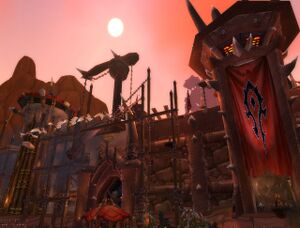
The orcs of Durotar follow Warchief Garrosh in the absence of Warchief Thrall. Their culture is split mostly between the orcs' warrior spirit and their shamanistic roots, which has recently wrought on conflict between the younger and older generations. Dedicated to carving out an existence in a world that has come to largely revile them, the orcs have recently turned their attention to reinvigorated conquests. Ashenvale and Stonetalon are among their first targets, and ultimately Warchief Hellscream intends to unite the entirety of Azeroth under a single banner.[29]
Darkspear tribe

The Darkspear of the Broken Isles have a very savage and dark history studying voodoo arts and worshiping the loa, however after Thrall had saved their tribe from extinction, Vol'jin son of Sen'jin pledged his tribe to the Horde. Some trolls have now began to study shamanism and more recently druidism, some of these trolls even mix shamanism with voodoo arts, most of the members of the tribe have or are attempting to give up the ways of cannibalism and the other traits of their race's darker history. After retaking much of their territory from the treacherous Zalazane, the Darkspear have been invited to join a revitalized troll empire under the Zandalari's leadership - though Vol'jin has declined this offer.
United Tauren Tribes
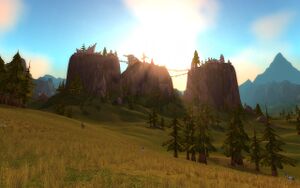
The noble tauren of Kalimdor are a race that had hunted the lands of central Kalimdor for generations, however when Thrall and his orcs had arrived onto the lands of Kalimdor they had already been driven near extinction by the marauding centaur that rampaged through their lands. Under the leadership of their high chieftain Cairne Bloodhoof and the young warchief Thrall, the tauren managed to drive back most of the centaur. Since then, Cairne has pledged his people to the Horde. After Cairne's death, the young Baine Bloodhoof has arisen to take his father's place and lead the tauren into a brighter future. With the recent Alliance incursion into the Barrens, the tauren have created a mighty gate to protect their homeland of Mulgore. Even if their Horde allies turn down dark paths during this war, the tauren have resolved to be the light that guides them through it.[30]
Bilgewater Cartel
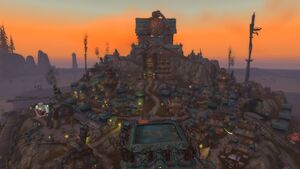
The cunning Bilgewater Cartel goblins from Kezan, one of the most (if not the most) powerful goblin cartels that dominates trade in the south seas, have recently joined the Horde. After Deathwing assaulted Kezan and the goblins were forced to flee, their first escape ships were attacked by an Alliance fleet. With a common enemy, the goblins assisted the captive former Warchief Thrall in breaking his bonds and obliterating the Alliance on the Lost Isles. Their future was tested when their leader, the angered Trade Prince Gallywix, attempted to defeat Thrall and take over Azshara for himself, though this ultimately ended in failure. Thrall mercifully allowed him to retain his position as Trade Prince, and thus the Bilgewater goblins were accepted into the Horde.
Forsaken
The Horde of the Eastern Kingdoms was initially next to non-existent, with only the Frostwolf orcs and other smaller forces in operation around the continent. In recent years, however, the Horde's presence has been bolstered by the inclusion of the Forsaken of Lordaeron and the blood elves of Quel'Thalas. While considered members of the Horde, their bonds with the western Horde are perhaps not on the same level as the orcs, trolls and tauren.
The Forsaken were once part of the Scourge, forced into mindless servitude under the Lich King. After the Lich King's grip began to weaken, the banshee queen Sylvanas Windrunner broke free from his will, and went on to both free and rally other undead beings to join her own empire of undeath, dubbed the "Forsaken." Under Lady Sylvanas' leadership, the Forsaken used any means necessary to conquer the fallen kingdom and remove both the dreadlords and other foes threatening their dominion. After expelling the Scourge from capital city and massacring the last remaining holdouts of the Alliance, they took over the catacombs of the former capital, renaming the city "Undercity."
With the backing of the tauren, Thrall warily accepted the Forsaken into the Horde, though this alliance of convenience has been tested - great betrayal at the hands of Grand Apothecary Putress has put the Forsaken on a tight leash, made tighter by the new Warchief's less lenient stance on their modus operandi.
Kingdom of Quel'Thalas
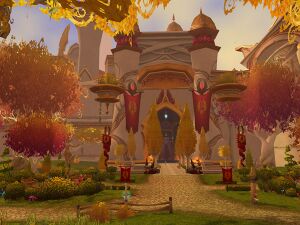
The blood elves of Quel'Thalas preside over the other major kingdom of the Eastern Horde. After the Scourge onslaught essentially culled the high elven race, with over 90% of their people killed, the remaining 90% vowed to avenge the destruction of their once-great nation and dubbed themselves the "blood elves" in honor of their fallen brethren. After retaking their homeland with the volatile new powers the magisters advocated, the kingdom of Quel'Thalas was offered aid from an unlikely source - the Forsaken, whose queen, Lady Sylvanas, had lost her life in her attempt to protect Quel'Thalas from the Scourge. With their assistance, the blood elves were able to fend off the lingering Scourge in the kingdom, and were able to enter the Horde as an equal nation of its own.
Quel'Thalas suffered another dark hour in recent years, when its twisted scion Kael'thas Sunstrider attacked his homeland in a mad bid to usher the Burning Legion's master into Azeroth. He was put to death for this on Quel'Danas, and Lor'themar Theron has thus become the sole leader of the blood elven people.
Videos
Lore For Noobs
- Lore For Noobs The Horde Part 1
- Lore For Noobs The Horde Part 2
- Lore For Noobs The Horde Part 3
- Lore For Noobs The Horde Part 4
- Lore For Noobs The Horde Part 5
- Lore For Noobs The Horde Part 6
- Lore For Noobs The Horde Part 7
- Lore For Noobs The Horde Part 8
- Lore For Noobs The Horde Part 9
- Lore For Noobs The Horde Part 10
- Lore For Noobs The Horde Part 11
- Lore For Noobs The Horde Part 12
- Lore For Noobs The Horde Part 13
- Lore For Noobs The Horde Part 14
- Lore For Noobs The Horde Part 15
References
- ^ Darkmoon Faire Cataclysm Promotion: Fortune card
- ^ "Beginnings and Ends"
- ^
 [30-35] Negotiations Terminated
[30-35] Negotiations Terminated
- ^
 [10-30] Silencing Rageroar
[10-30] Silencing Rageroar
- ^ Theldurin the Lost
- ^ Arthas: Rise of the Lich King, p247
- ^
 [5-30] Lessons in Fear "No humans were used. <Walden laughs.> Rightfully, they fear being reanimated as Forsaken."
[5-30] Lessons in Fear "No humans were used. <Walden laughs.> Rightfully, they fear being reanimated as Forsaken."
- ^ http://us.battle.net/wow/en/game/race/blood-elf
- ^ In the Shadow of the Sun
- ^
 [5-30] Disturbing Connections
[5-30] Disturbing Connections
- ^
 [5-30] Ending the Threat
[5-30] Ending the Threat
- ^
 [30-35] Kor'kron Drop
[30-35] Kor'kron Drop
- ^
 [10-30] Reinforcements...
[10-30] Reinforcements...
- ^
 [10-30] Kobold Fury!
[10-30] Kobold Fury!
- ^
 [15-30] Futile Pride
[15-30] Futile Pride
- ^ "The Founding of Durotar: A Blaze of Glory Map: Theramore Isle", Warcraft III: The Frozen Throne. Blizzard Entertainment. Admiral Proudmoore: "Can your blood atone for genocide, orc? Your Horde killed countless innocents with its rampage across Stormwind and Lordaeron. Do you really think you can just sweep all that away and cast aside your guilt so easily? No, your kind will never change, and I will never stop fighting you.".
- ^ Alliance & Horde Compendium, pg. 55. Quote: Although the brave and foolhardy Proudmoore and the men and women who followed him are gone, many of Theramore's citizens agreed with their actions.
- ^ Horde Player's Guide, pg. 175. Quote: For the time being, the Horde is now our most "obvious" enemy, in that they are numerous, and old hatreds put the fight with them at the top of nearly every priority list.
- ^ Tides of War
- ^
 [15-35] The Horde Is Family
[15-35] The Horde Is Family
- ^
 [15-35] De-Subjugation
[15-35] De-Subjugation
- ^
 [15-35] A Gathering Storm
[15-35] A Gathering Storm
- ^
 [15-35] Get My Results!
[15-35] Get My Results!
- ^
 [15-35] What's in the Box?
[15-35] What's in the Box?
- ^
 [15-35] One Last Grasp
[15-35] One Last Grasp
- ^ World of Warcraft manual, 182
- ^


 [1-20] The Horde Way
[1-20] The Horde Way
- ^
 [90] The Measure of a Leader
[90] The Measure of a Leader
- ^
 [30-35] Call of Duty
[30-35] Call of Duty
- ^ Baine Bloodhoof
| |||||||||||||||||||||||||||||
| |||||||||||||||||||||||
es:Horda fr:Horde

